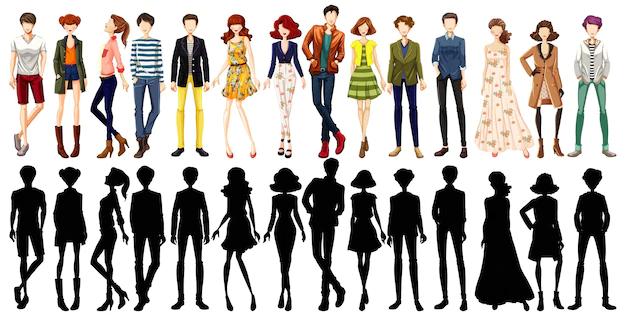Optimizing Swimsuit Selection: A Comprehensive Guide to Flattering Silhouettes
Selecting swimwear significantly impacts an individual's comfort and self-perception, especially during summer activities. This guide provides a structured approach to swimsuit selection, focusing on body awareness, strategic styling, and confidence enhancement. We will explore key concepts: somatotyping (body type classification), Gestalt principles (perceptual organization), color psychology (impact of color on mood and perception), and ergonomic design (relationship between the human body and its environment). These principles are applied to create a flattering and comfortable swimsuit experience.
Understanding Body Morphology and its Influence on Swimsuit Selection
Effective swimsuit selection begins with accurate somatotyping. Common body types include hourglass, pear, apple, rectangle, and inverted triangle. Recognizing these morphologies allows the application of Gestalt principles, specifically using garment design to balance proportions and create visual harmony. For example, an hourglass figure benefits from swimsuits emphasizing the waistline, while a pear shape may benefit from styles balancing wider hips with a more defined upper body. This approach utilizes the holistic perception of form and balance, central to Gestalt psychology, to create a visually appealing silhouette.
Strategic Styling Techniques: Enhancing Proportions and Highlighting Assets
After identifying body shape, strategic swimsuit style and design element selection optimizes visual presentation. This involves design principles like emphasizing positive attributes and minimizing perceived flaws. Vertical lines and strategically placed ruching create a lengthening effect; high-waisted bottoms offer a balanced silhouette. Color psychology is crucial: darker colors generally slim, while lighter shades add visual volume. This aligns with the principles of color psychology's impact on perceived body image, influencing the overall aesthetic impact.
Color Theory and Pattern Application: Mastering Visual Perception
Color and pattern significantly influence a swimsuit's visual impact. Darker, saturated colors (e.g., navy, black) create a slimming effect by minimizing perceived size, whereas brighter colors and bold prints draw attention and add visual interest, illustrating principles of color theory. Strategic pattern application – vertical stripes for lengthening, horizontal stripes to create curves – is crucial. Integrating visual perception and color theory principles creates a flattering, aesthetically pleasing silhouette.
Ergonomic Considerations: Prioritizing Comfort and Support
Ergonomic principles, focusing on the human body's interaction with its environment, are central to swimsuit selection. Comfort and support are paramount. For larger busts, swimsuits with underwire, adjustable straps, or built-in cups provide adequate support and prevent discomfort. The swimsuit should fit snugly but not restrictively, ensuring comfort and security during activity. Avoiding pinching or binding garments ensures a positive wearer experience, contributing to confidence and well-being. This emphasizes the importance of functionality and comfort in swimsuit design.
Swimsuit Styles and Versatility: A Multifaceted Approach to Choice
The market offers diverse swimsuit styles. One-piece suits offer versatility with cutouts and high-cut legs. High-waisted bottoms provide tummy control and a retro aesthetic. One-shoulder styles highlight the neckline and shoulders. Swim dresses provide coverage and a feminine silhouette. Swimsuit choice should align with individual preferences and lifestyle, ensuring style and practicality. Accessorizing adds versatility. This demonstrates the application of design and fashion principles in creating a personalized style.
Customization through Separates: Tailoring the Perfect Fit
Purchasing swimsuit separates allows unparalleled customization, especially beneficial for individuals with differing upper and lower body measurements. This approach optimizes comfort and aesthetic appeal, creating a personalized fit that flatters individual body proportions. This highlights the importance of accommodating individual body variations through adaptable clothing design.
In-Person Fit Assessment: The Importance of Direct Evaluation
Prior to purchase, in-person fit assessment is crucial. Brand sizing variations necessitate proper fitting to ensure optimal support, comfort, and aesthetic appeal. Direct evaluation allows immediate identification and correction of fit issues, preventing discomfort and maximizing the confidence-boosting effect of properly fitted swimwear. This step underscores the limitations of standardized sizing and highlights the need for individualized evaluation.
Cultivating Confidence and Self-Acceptance: The Foundation of Positive Body Image
Swimsuit selection should be guided by self-acceptance and confidence. The most flattering swimsuit makes an individual feel comfortable, confident, and empowered. Embracing one's unique body shape and appreciating individual beauty is paramount. Prioritizing the confidence boost from comfortable, well-fitting swimwear over adhering to trends contributes to positive self-image and well-being. This aspect transcends fashion and connects to self-esteem and mental health.
Conclusion and Recommendations
In conclusion, selecting a flattering swimsuit requires a holistic approach encompassing body awareness, strategic styling, color psychology, ergonomics, and self-acceptance. Understanding visual perception, color theory, and ergonomics allows individuals to select swimwear enhancing natural features and creating a balanced visual impression. Further research could explore cultural influences on swimsuit preferences and body image, and the development of more inclusive sizing systems. This analysis contributes to a more empowered approach to swimsuit selection, fostering positive body image and well-being. This integrated approach promotes body positivity and a more confident, enjoyable experience. A future research direction could involve quantitative studies analyzing the impact of specific design elements on perceived body image and consumer satisfaction. This would provide stronger empirical evidence to support the design principles discussed in this guide.Reader Pool: How might the integration of virtual fitting technologies influence consumer decision-making and enhance the swimsuit selection process?



